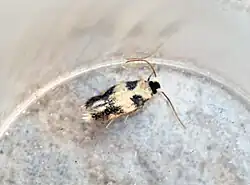Ectoedemia decentella
| Ectoedemia decentella | |
|---|---|
 | |
| Scientific classification | |
| Kingdom: | Animalia |
| Phylum: | Arthropoda |
| Class: | Insecta |
| Order: | Lepidoptera |
| Family: | Nepticulidae |
| Genus: | Ectoedemia |
| Species: | E. decentella |
| Binomial name | |
| Ectoedemia decentella (Herrich-Schaffer, 1855)[1] | |
| Synonyms | |
| |
Ectoedemia decentella is a moth of the family Nepticulidae found in Europe. It was described in 1855, by the German entomologist and physician, Gottlieb August Wilhelm Herrich-Schäffer.
Description
The wingspan is 5–81 mm. There are two generations per year, with adults on wing in June and again in August.[2]
The larvae feed on field maple (Acer campestre), Montpellier maple (Acer monspessulanum), Acer obtusatum, sycamore (Acer pseudoplatanus) and Cretan maple ((Acer sempervirens). Pupation takes place outside of the mine.[3]
Distribution
It is found from Sweden to the Iberian Peninsula, the Alps and Greece, and from Great Britain to Ukraine.[1]
References
- ^ a b "Ectoedemia (Etainia) decentella (Herrich-Schäffer, 1855)". Fauna Europaea. Retrieved 14 March 2023.
- ^ Kimber, Ian. "Etainia decentella (Herrich-Schäffer, 1855)". UKmoths. Retrieved 14 March 2023.
- ^ Ellis, W N. "Etainia decentella (Herrich-Schäffer, 1855) sycamore-seed pigmy". Plant Parasites of Europe. Retrieved 14 March 2023.